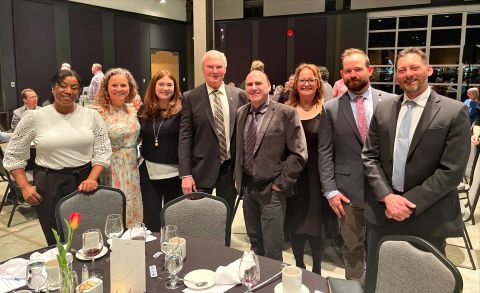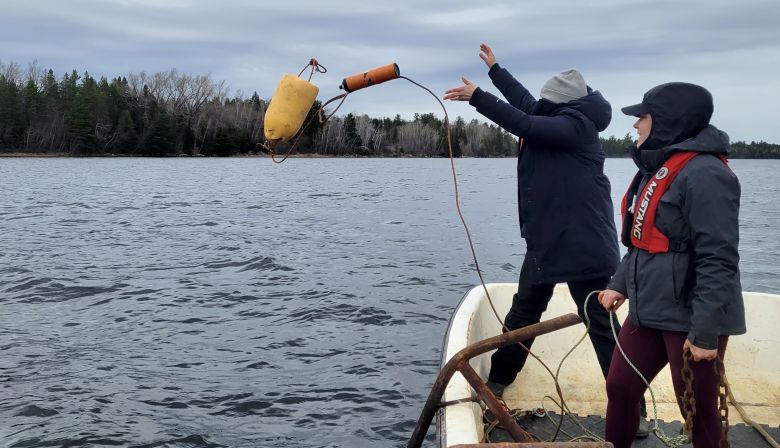
Subscribe & stay up-to-date with ASF

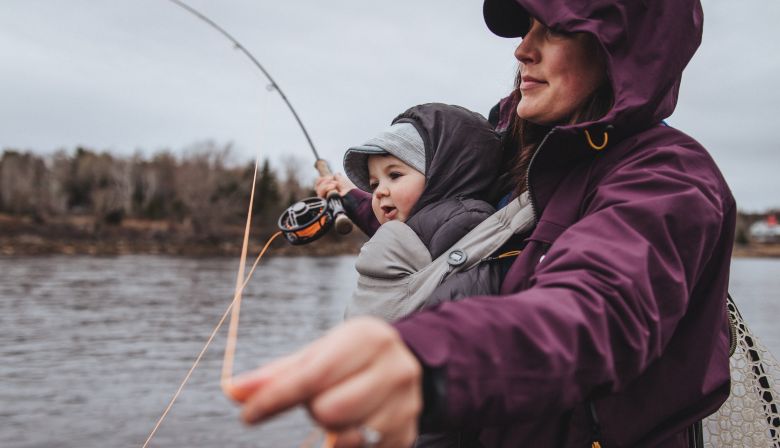
I’ve just returned from town and stopped to indulge in a few quick flicks before making my way home—a luxury afforded since moving to the St. Mary’s, a small community on the Eastern Shore of Nova Scotia. It’s one that I am especially grateful for now, as a new mom, with a six-month-old in tow. While, at times, I long for those dawn to dusk adventures of seasons past, seeing my son’s response to being in nature at this early age, I realize an entirely new adventure awaits.
Join me this season as we explore the important work ASF is conducting on behalf of Atlantic salmon. And as we share stories of these majestic fish and the rivers they call home.
• 13 in the outer bay
• 6 on the main stem in the city of Miramichi
• 5 on the Southwest Miramichi, up as far as Quarryville
• 8 on the Northwest Miramichi, up as far as Kingston Lane
Graham Chafe, says:
It’s a big help to have Anqotum staff along with this project. They are involved in both the deployment of receivers and our smolt tagging work.
Katie and Kayla came with me for a long, cold day on the Miramichi River. We started at Ritchie’s Wharf and spent 4 hours going up as far as Quarryville on the Southwest and Red Bank on the Northwest. We deployed about a dozen receivers up and down.
It started off cold, but got windier and rainier as the day went. In the afternoon, we went from Ritchie’s Wharf in Miramichi, down to Loggieville where the river opens to the bay, and placed 5 receivers along the route.
An additional receiver will be deployed this week at the smolt capture/tagging site on the Northwest, near Wayerton Bridge, and 7 more along the Southwest (3 gates of 2 receivers and 1 single). The uppermost is just a few kilometres downstream from Rocky Brook camp, where our team will be tagging Southwest stock.


ICES, the International Council for Exploration of the Sea, is an international scientific body based in Copenhagen, Denmark with its 20 members being most of the countries around the North Atlantic. ICES provides peer-reviewed scientific advice on fish, fisheries and the marine environment in response to questions from member countries and regional fisheries management organizations, as well as others. ICES does so through the use of Working Groups responding to questions posed to them. There are dozens of such working groups, as well as specialized study groups.
The Working Group on North Atlantic Salmon (WGNAS) is one of those such groups, and ICES had scheduled to meet them from March 28-April 7, 2022. At the start of March however, ICES announced that they were cancelling, or postponing all working group meetings until at least early April, pending further decisions of the ICES Council. This was due to the Russian invasion of Ukraine. (Russia is a member of ICES, the Ukraine is not). At the end of March, ICES announced that meetings could proceed but were not to include any participation by Russia (Statement from ICES Council).
The Chair of the WGNAS decided that it was too late to reschedule a meeting in April or May, in time to produce new advice to NASCO. ICES then decided that they would issue advice to NASCO in the absence of a 2022 WGNAS meeting, using the 2021 WGNAS report, as some forecast information from that report was applicable to both 2022 and 2023 fisheries. For 2022, NASCO posed a series of questions to ICES.
So what does not having a 2022 WGNAS Report mean?
We will not have information on catches of salmon in the various fisheries around the North Atlantic in 2021. This would have included the catches in recreational and subsistence fisheries in Quebec, NB, NS, PEI, and Newfoundland and Labrador, as well as the information on released angled fish in those areas, and estimates of the amount of poaching (unreported catches). We do not have information on the catches and number of fishers at St. Pierre et Miquelon in their gill net fisheries nor those from West and East Greenland. The weight of such catches are being reported separately to NASCO by those countries, but this doesn’t include information on the timing of the catches, numbers of salmon, stock composition in the fisheries and biological characteristics of the catch.
The WGNAS also provides estimates annually on total returns and spawners in each year (by sea-age) to various areas of North America; we do not have these for 2021 and these numbers are used, along with distant water catches, to develop the graphs of Pre-Fisheries Abundance that ASF has previously reproduced in our ‘State of the Populations’ Report. Catches and subsequent return information is also used to estimate exploitation rates in various fisheries such as at West Greenland, and monitor how this rate changes with regulatory change.
In addition, WGNAS reports annually on the achievement of ‘conservation limits’ in about 75 rivers of eastern Canada and the USA; we don’t have these for 2021, nor do we have estimates of marine survival in 2021 for about 10 monitored populations where known smolt numbers from previous years are evaluated against current returns. And we do not have the smolt production information for about 10 rivers in 2021 (a measure of freshwater productivity).
NASCO is meeting during the first week of June 2022 and will develop a new request for Scientific Advice from ICES. If all goes well, ICES will request the WGNAS to address these and they will likely meet in March of 2023. At that time, they will input both 2021 and 2022 information on catches, returns, etc. into their models and will provide new multi-year advice for fisheries.
The lack of data from ICES will make it difficult to assess the overall population status of wild Atlantic salmon for this year. However, many regions and individual rivers have reported 2021 data. For example, see below for counts from Quebec.
In Maine, River Herring are pouring in, however no adult Atlantic salmon have migrated upstream to date. According to Jason Valliere with Maine DMR, they are expected any day now. At the smolt trap, operated on the Sandy River, an important tributary to the Kennebec River in western Maine and a focus area of restoration for ASF, there have been record numbers. Last Friday, Jennifer Noll with Maine DMR reported 189. When the smolt trap operated last year on this river, the daily trap never topped 150. A very promising sign of the potential population out-migrating.
Last year Maine DMR estimated a population of over 13,000 smolts using a mark-recapture study with the smolt trap on the Sandy River. This is one of the largest documented populations of out-migrating endangered Atlantic salmon smolts in the state of Maine and validates the exceptional productive habitat across the drainage.
Colby W. B. Bruchs, Fisheries Scientist with Maine DMR writes:
Maine DMR operates rotary screw traps to enumerate emigrating Atlantic salmon smolts on the Narraguagus River (Little Falls and Route 9) and Sandy River (Lane Road).
River levels are low, water temps are rising and smolt runs are in full swing! Site summaries linked below:
Sandy River Smolt Project Daily Summary | May 10, 2022 | Jen Noll, DMR
Narraguagus River Smolt Project Daily Summary | May 12, 2022 | Colby Bruchs, DMR
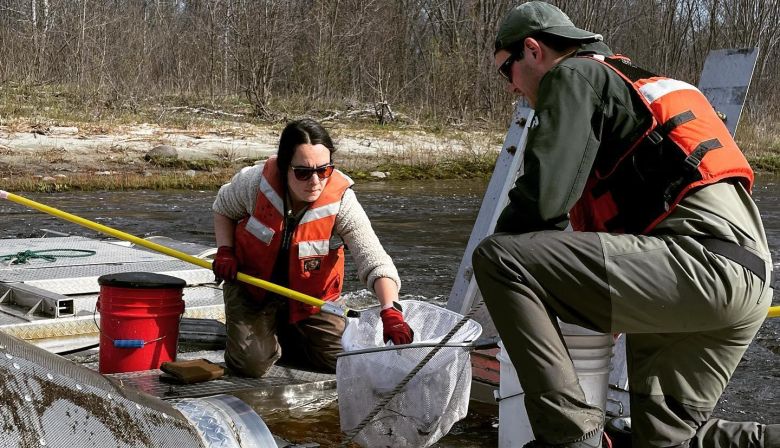
Le gouvernement du Québec a publié son bilan pour l’année 2021, en voici un sommaire.
Au Québec, 114 cours d’eau sont officiellement désignés comme des rivières à saumon. La pêche se pratique dans environ les deux tiers de ces rivières et tributaires, qui se répartissent dans 11 zones salmonicoles. La pêche a été permise sur 75 cours d’eau et 5 tributaires en 2021.
Au Québec, en 2021, dans les 39 rivières (38 en 2020) où des dénombrements ont été effectués,
28 601 saumons adultes ont été enregistrés (30 291 en 2020). Les rivières dénombrées ont accueilli 90% de l’effort de pêche sportive.
Les captures totales par la pêche sportive se chiffrent à 15 265 saumons (14 163 en 2020), dont 10 087 (9 769 en 2020) ont été remis à l’eau.
Parmi les saumons pris et gardés, 4 442 (3 477 en 2020) étaient des madeleineaux et 736 (907 en 2020), des rédibermarins.
L’année 2021 se caractérise par une hausse de 14 % (19% en 2020) des montaisons totales, comparativement à la moyenne quinquennale, les montaisons de madeleineaux ayant été supérieures de 52 % (- 5% en 2020) alors que les retours de rédibermarins sont légèrement inférieurs à la moyenne de 4 % (+33% en 2020).
Ces résultats sont issus de l’analyse des 31 rivières pour lesquelles des données sont disponibles pour chacune des 6 dernières années. La récolte de madeleineaux à la pêche sportive a été de 14 % supérieure à la moyenne quinquennale en raison de leur forte abondance dans les rivières. La récolte des rédibermarins a, quant à elle, diminué de 47 % et atteint le nombre plus faible jamais enregistré depuis 1984.
Parallèlement à cela, la vente de permis en 2021 a augmenté de 14 % comparativement aux cinq années précédentes, et ce, malgré une diminution de 59 % des permis vendus aux non-résidents.
Seuils de conservation : (Génétique, démographique, optimal)
Le seuil de conservation optimal est le point de référence biologique basé sur des critères démographiques qui permettent de déterminer si une population doit être classée dans la zone saine ou pas. Une population est considérée comme saine si elle atteint ou dépasse ce niveau d’abondance.
Il s’agit d’un niveau d’abondance qui permet d’être certain à 95 % et plus que la population est dans une situation permettant un rendement maximal durable. Le seuil de conservation optimal s’apparente au seuil de conservation qui a été utilisé au Québec de 1999 à 2015, mais est en moyenne 1,5 fois plus élevé.
Notons toutefois que l’ampleur de la différence entre les deux valeurs varie d’une rivière à l’autre. Les valeurs de ce point de référence, tout comme celles du second point de référence basé sur des critères démographiques, s’expriment typiquement en ombre d’œufs et varient d’une rivière à l’autre en fonction de la superficie et de la qualité de l’habitat des rivières.
_
The Quebec government recently published the 2021 Atlantic Salmon Exploitation Report. A summary follows:
In Quebec, 114 waterways are officially designated as salmon rivers. The fishing for this species is practiced in approximately two-thirds of these rivers and tributaries, which are divided into 11 salmon angling management areas. Fishing was permitted on 75 watercourses and 5 tributaries in 2021.
In 2021, in the 39 rivers (38 in 2020) where assessments were carried out, 28,601 adult salmon were recorded (30,291 in 2020). These rivers represent 90% of the sport fishing effort.
Reported angling catches totaled 15,265 salmon (14,163 in 2020), of which 10,087 (9,769 in 2020) were released.
Of the salmon that were harvested, 4,442 (3,477 in 2020) were grilse and 736 (907 in 2020) were large salmon. The lowest large salmon harvest since 1984.
The 2021 season was characterized by a 14% increase (19% in 2020) in total migration, compared to the five-year average, grilse returns increased by 52% (-5% in 2020) while the returns of large salmon decreased slightly by 4% (+33% in 2020).
These results represent the analysis of the 31 rivers for which data are available for each of the last 6 years.
At the same time, the sale of permits in 2021 increased by 14% compared to the previous five years, despite a 59% decrease in permits sold to non-residents.
Conservation thresholds: (Genetic, demographic, optimal)
The optimal conservation threshold is the biological reference point, based on demographic criteria, that determines whether a population is classified within the healthy zone. A population that reaches or exceeds this abundance level is considered healthy.
This threshold marks the level at which the population is abundant enough that it can allow for a maximum sustainable yield with 95% certainty or more. The optimal conservation threshold resembles the conservation threshold that was used in Québec from 1999 to 2015 but is on average 1.5 times higher.
Please note: the magnitude of the difference between these two values varies from river to river. As with the values of the second reference point based on demographic criteria, the values of this reference point are typically expressed by the number of eggs deposited and vary from river to river depending on the river’s size and habitat quality.

With most areas opening to fishing on April 1st, and many of the delayed openings set to lift on Sunday, May 15th, the fishing season is now truly underway in Nova Scotia. The angling season opened in PEI on April 15th. By all reports fishing season has kicked off well this year. There were no issues obtaining angling licenses, especially as you can do so now online. Check with your local vendor, Fish and Wildlife on PEI, or NS Inland Fisheries Division to find out more. Fishing around the Bras D’Or lakes seemed especially good with anglers reporting they are catching plenty of fish. Rumours abound once again about escapees from the open net pen cages, but the fishers I spoke to were delighted to be out and into fish.
As most of the salmon runs in NS and PEI are fall runs, and salmon season not likely to open on the Margaree until June 1, there isn’t much to report respecting water levels or salmon fishing opportunities. There is however a lot happening as groups across the two provinces gear up for another season of research and conservation work.
Black salmon, or kelts, are adult fish who would have successfully spawned last fall and that return to the ocean in the early spring to feed and grow, to hopefully become a repeat spawner. In PEI and NS there is not a spring season for these fish. However, there were a few anglers who were out in April seeking kelts under a special scientific license. Their goal was to attach special tags on these fish that will help track their movements. This work often referred to as the ESRF project, after the funder (Environmental Studies Research Fund), is being led by DFO but involves many partners throughout Nova Scotia and PEI. ASF was out with some of these groups this spring helping to attach the transmitters to the fish. When out speaking with angling volunteers, it seemed that the kelt run was early this season.
As the spring run of our kelts wind down, the focus for some of our local affiliates will shift to tagging or assessing the population of smolts – juvenile salmon making their first trip to the ocean to grow and mature. The Stewiacke, Medway, LaHave, West River Sheet Harbour, St. Mary’s, and Margaree rivers all may have smolt wheels installed to help with the capture of smolts and facilitate this work. If you come across one of these wheels, keep your distance as they can be dangerous. But certainly please call out to anyone you see working at the wheels. I know from my time running smolt wheels, we were always glad to chat with passerby’s and local anglers.
As the smolt begin to run, anglers should be mindful to ensure they can recognize the difference between these young salmon and their trout cousins. There are a few great resources to help you with this that are put out by angling groups and DFO. Some of the things I look for when identifying salmon smolt are large pectoral fins, that do not have a white leading edge, and a clear adipose fin. If you do happen to capture a smolt by mistake, follow the usual catch and release best practices: play the fish quickly, keep it wet, and let it go as fast as possible. Before you release it, be sure to give it a kind word and a good pep talk about returning to the river one day as a nice 40 pounder.
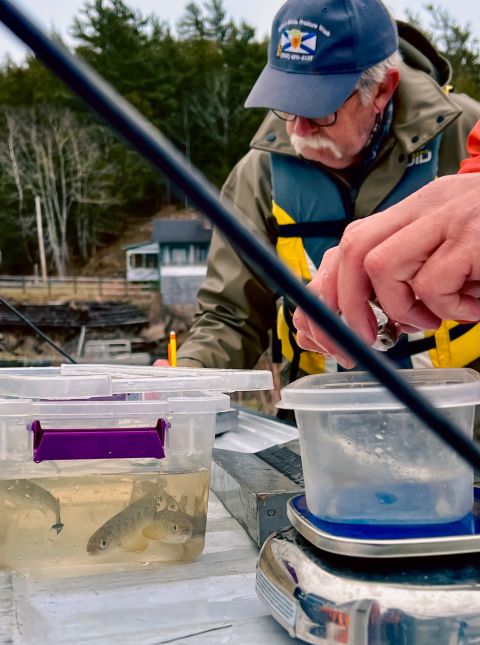
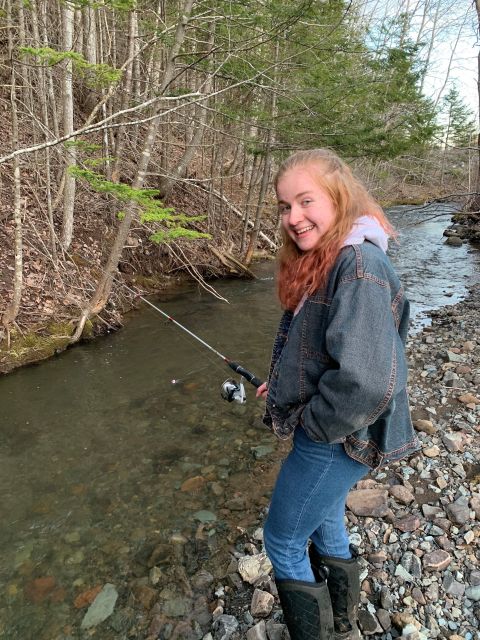
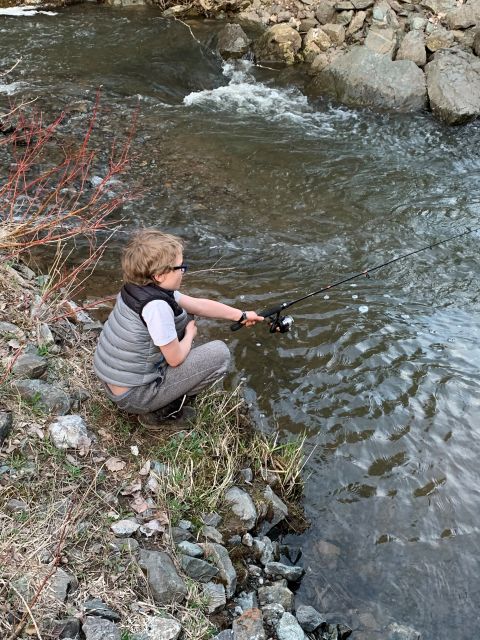
One question that is on every angler’s mind this time of year is “What will returns be like this year?” If you ask DFO’s Science or Management Branch, they will likely tell you that with countless variables at play, it is nearly impossible to predict salmon returns from one year to the next. However, we have approximately 300 salmon rivers in the province of Newfoundland, yet roughly only twenty of those have adult counts, with smolt counts on just five. And the situation is not much brighter in the area of marine science, as DFO’s tracking research on Atlantic salmon in this environment is relatively new.
Despite limited data, there are factors that can help us gauge expected returns from one year to the next. For instance, in 2017 adult salmon returns were low in NL, meaning fewer eggs would have been deposited in spawning grounds that year. Since salmon generally have a five-year life cycle on the island of Newfoundland, one could surmise that based on this metric alone, we might expect to see low returns in 2022. Where Labrador generally has a seven-year life cycle, we might expect to see greater returns there in 2022, as returns were higher in 2015.
Another factor worthy of our consideration is smolt out-migration. As the majority of our rivers produce one sea-winter grilse, should large numbers of smolt leave the river in a given year, and all other variables remain constant; we might expect a greater number of grilse returning the following year. Unfortunately, as noted above, we only had smolt counts from five rivers in 2021. And of the five assessed, the counts from four were low. With such a small sample size, it is indeed difficult to make accurate predictions.
It is encouraging to note that we had a tremendous amount of snow in Western Newfoundland and on the Northern Peninsula this past winter. Current water levels in these two areas are high, and snow remains in the high country, with ice in many lakes. All this to say, angling conditions should be prime for opening day on June 1st.
Labrador also had large amounts of snowfall this winter, with very cold temperatures. This translates to an increased likelihood that water levels will be high on Labrador come opening day of June 15th.
On the contrary, Central and Eastern portions of the Island of Newfoundland experienced very little snowfall. While current water levels are fair, significant rainfall will be needed throughout June and July, to prevent critically low conditions.
As a reminder, in the spring of 2021, DFO released a two-year Recreational Salmon Management Plan for Newfoundland and Labrador. Salmon licences for the 2022 recreational salmon season are now available for purchase at vendors throughout NL. DFO is expected to start counting adult returns once water levels allow for the installation of counting facilities.
Links for quick reference:
2022 Recreation Salmon Season Dates https://www.nfl.dfo-mpo.gc.ca/…
Retention limits https://www.nfl.dfo-mpo.gc.ca/…
Catch and Release limits https://www.nfl.dfo-mpo.gc.ca/… .
We are pleased to report that the dinner was well attended, with over 250 guests and approximately $130,000 in funds raised. Thank you to all who were involved in making this gathering an outstanding success. Your passion, generosity and enthusiasm is what drives these events. We could not accomplish what we do without your support. Thank you!
Stay tuned for further reports on upcoming ASF events.
